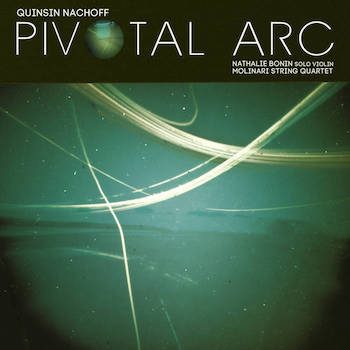Jazz Album Review: Quinsin Nachoff’s “Pivotal Arc” — Rhythmic Vitality Galore
By Michael Ullman
This is demanding contemporary music that succeeds at the trick of pulling you in — and makes you glad to be there.
Pivotal Arc, Quinsin Nachoff, with Nathalie Bonin, violin soloist, and the Molinari String Quartet. (Whirlwind)

“Pivotal Arc” is the third piece on Canadian saxophonist Quinsin Nachoff’s new disc, and it’s the one that most resembles traditional jazz. Gunther Schuller would have called it — as well as the Violin Concerto and String Quartet that precede it — third-stream music. The category doesn’t matter.
The music on this disc is exciting, active, and intelligent. Conducted by JC Sanford, Nachoff’s music is rhythmically vibrant, coherent, and, especially in the case of the Violin Concerto that opens the collection, respectful of tradition. Like a Mozart concerto, the concerto has three movements: the opening substantial, the middle movement slow, and the last upbeat. Violinist Nathalie Bonin has a cadenza, of course — she’s a virtuoso — but much of the piece is conversational. The band consists of winds and a rhythm section and the Molinari Strng Quartet. All praise is due to drummer Satoshi Takeshi and bassist Mark Helias for making the piece swing. Its lengthy opening movement begins with a solo violin statement, its repeated phrases cuing us into what is to come. What I take to be the main theme is repeated in various textures by the band, including by the brass around two minutes in, and then the violin plays against the rhythm, which resembles a tango. (Stravinsky wrote a tango for chamber orchestra. Imagine a tango written by a Stravinsky with a jazz background, and you have some of the flavor of Nachoff’s piece.) There’s a kind of explosion after about five minutes, and then Bonin plays a second theme over the rhythm section. She sounds serene, occasionally rhapsodic: the rhythm, including vibraphonist Michael Davidson, nervy. It’s a tango that gradually gains intensity until the violin temporarily drops out. There’s a drum solo: the drum set seems to take the place of the violin in the conversation. Eventually Bonin leaps back in. After around 13 minutes there’s a stop and a more exposed section for the violin, including some bars over pizzicato strings.
What impresses this listener is the rhythmic vitality above all, and the shifting textures in a movement that seems both improvisatory and logically controlled. The second movement begins as a series of solo statements by the violin answered in various ways: by solo trumpet, by varying members of the band. The last movement is meant to evoke Balkan music. In the context it sounds, if not humorous, at least as good-humored as a kind of rough dance music.
The four-movement string quartet offers fewer textures, of course. It also has a propulsive force that seems inevitably part of Nachoff’s music, a foot-tapping rhythm or series of rhythms made lively by irregular accents, and harmonically and melodically interesting by the vigor of the interchanges among musicians and by devices like saggings of pitch. A cello plucks a solo in the slow movement as the upper strings play notes that seem to smear downward in contradiction to the clarity of what the cellist is attempting. “Pivotal Arc” begins in a hush with strings playing eerily behind a bowed bass solo. The bass drum introduces a repeated pattern and the band comes in with long, ominous tones over it. Suddenly there’s a kind of scurrying pattern that is silenced as the drummer plays on a cymbal and bass drum. The piece has become momentarily a percussion solo. The band returns briefly and then we hear various rattlings, bells, and wood blocks, and what sounds like items dragged across a snare drum. The reeds return with a twittering pattern, and then we hear a more traditional drum solo. Again the winds and strings return in layered fashion. Finally, Nachoff comes in soloing on saxophone over the rhythm section. It’s beginning to sound like jazz.
I’ve mentioned repeatedly the rhythmic vigor of Nachoff’s writing. I find much more than that appealing: there’s the variety in the textures, shaped by an engagingly complex musical mind, a sensibility that guarantees the progress of each movement will contain a series of delights and surprises. It’s demanding contemporary music that succeeds at the trick of pulling you in — and makes you glad to be there.
Michael Ullman studied classical clarinet and was educated at Harvard, the University of Chicago, and the U. of Michigan, from which he received a PhD in English. The author or co-author of two books on jazz, he has written on jazz and classical music for the Atlantic Monthly, New Republic, High Fidelity, Stereophile, Boston Phoenix, Boston Globe, and other venues. His articles on Dickens, Joyce, Kipling, and others have appeared in academic journals. For over 20 years, he has written a bi-monthly jazz column for Fanfare Magazine, for which he also reviews classical music. At Tufts University, he teaches mostly modernist writers in the English Department and jazz and blues history in the Music Department. He plays piano badly.

Finally!
A music reviewer who really gets it.
I’ve been following Quinsin’s music for two and a half decades. It’s so nice to have a comprehensive critique of his latest music.
Thanks,